Today, the Arleigh Burke class destroyers are the backbone of the US fleet, with 67 ships in service. The lead ship of the class, named for an Admiral who helped pull the US Navy up from some of its darkest days, was commissioned on July 4th, 1991, and three evolved variants were ordered in FY20,1 with more still to come. This longevity and flexibility is particularly impressive for a design that ultimately dates back to the 1980s and was intended to face a threat which no longer exists.
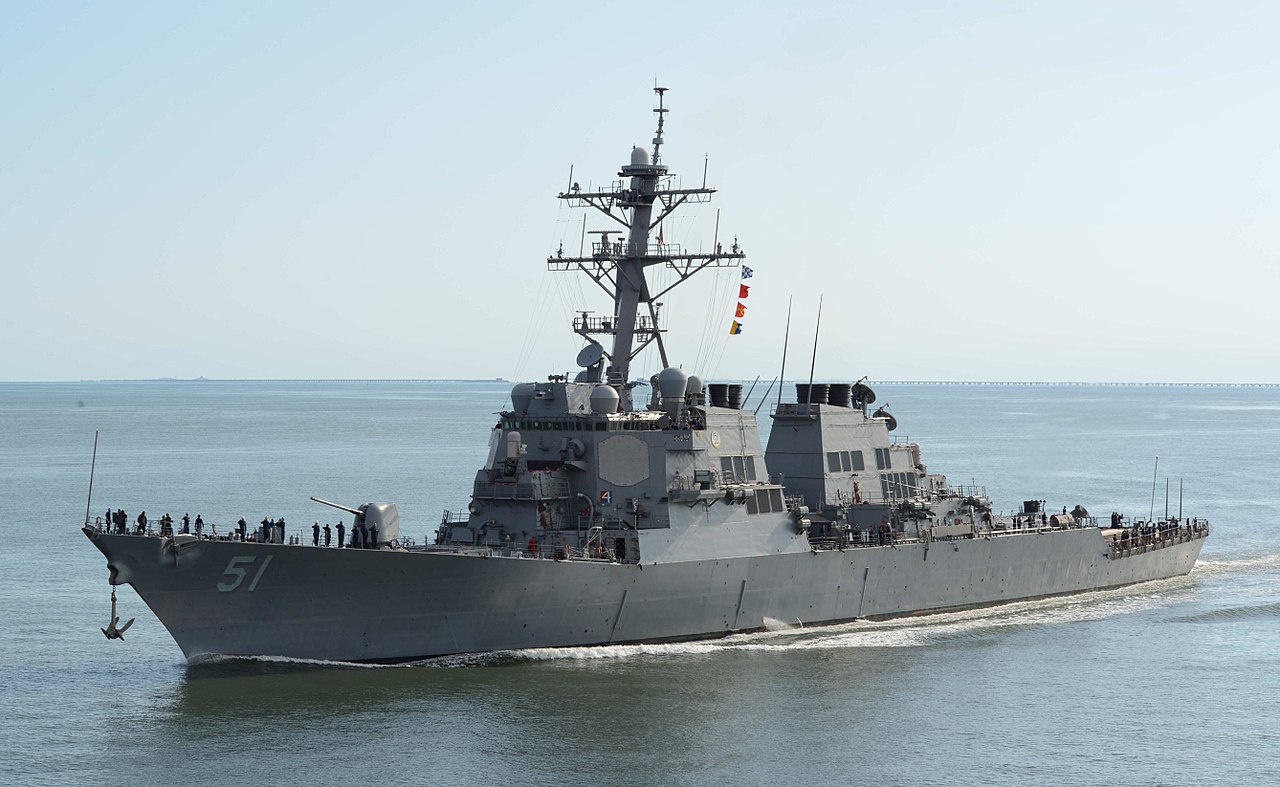
Arleigh Burke underway
Shortly after entering office, the Reagan Administration came up with a new strategy for fighting the Cold War at sea. Instead of passively trying to protect convoys crossing the North Atlantic, they would dispatch a carrier striking force into the Norwegian Sea, threatening Soviet bases in the Arctic and drawing out their bombers to be destroyed. One of the cornerstones of this strategy was Aegis, which gave reasonable confidence that the escorts could shoot down any incoming missiles, freeing the F-14s to go after the bombers in the so-called Outer Air Battle.
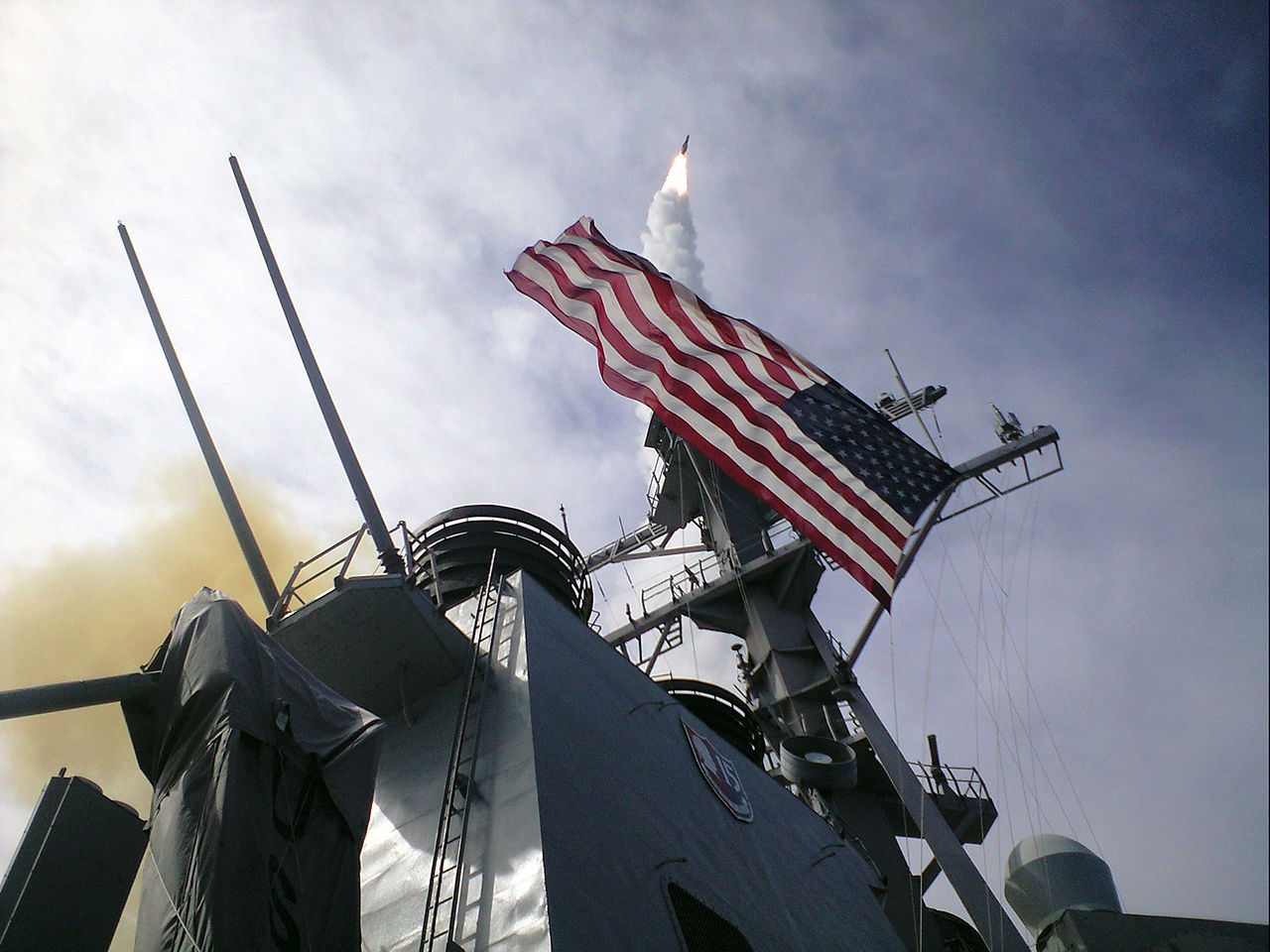
A Standard SM-2 launches from the VLS aboard Lassen (DDG-82)
This strategy would require a great deal of anti-air firepower on the part of the fleet, particularly as many of the Navy's early missile ships would be in need of replacement by the early 90s. The Ticonderoga class cruisers, though capable ships, were seen as too expensive to buy in the numbers needed, so work began on a new destroyer that would balance combat capability with low acquisition cost. Besides being fitted with Aegis, the new destroyer would also have a vertical launch system, capable of carrying not only Standard SAMs but also VL-ASROC anti-submarine missiles and the new Tomahawk cruise missile. This gave it an important secondary role as a strike platform to back up the carriers, and also helped frustrate the Soviet ocean surveillance system, which was tasked with keeping track of all nuclear-capable ships. This had been easy when that was just the carriers, but much harder when it basically meant every US warship.
Anzio of the Ticonderoga class
But some cuts were required to bring the ship in at its goal of 75% of the capability of a Ticonderoga at 75% of the price. The Aegis system was more austere, with only two instead of four large displays, three rather than four illuminators, and one rather than two radar transmitters. As none of the ships being replaced had aviation facilities, the new ships would have only a helicopter pad, and not a hangar, which meant no onboard helicopter. Various advanced propulsion schemes were discussed, but to reduce cost and risk, the same configuration of four LM2500 gas turbines on two shafts used on the Spruance and Ticonderoga classes was ultimately adopted. This provided approximately 100,000 shaft horsepower, which could drive the ship to 31 kts.
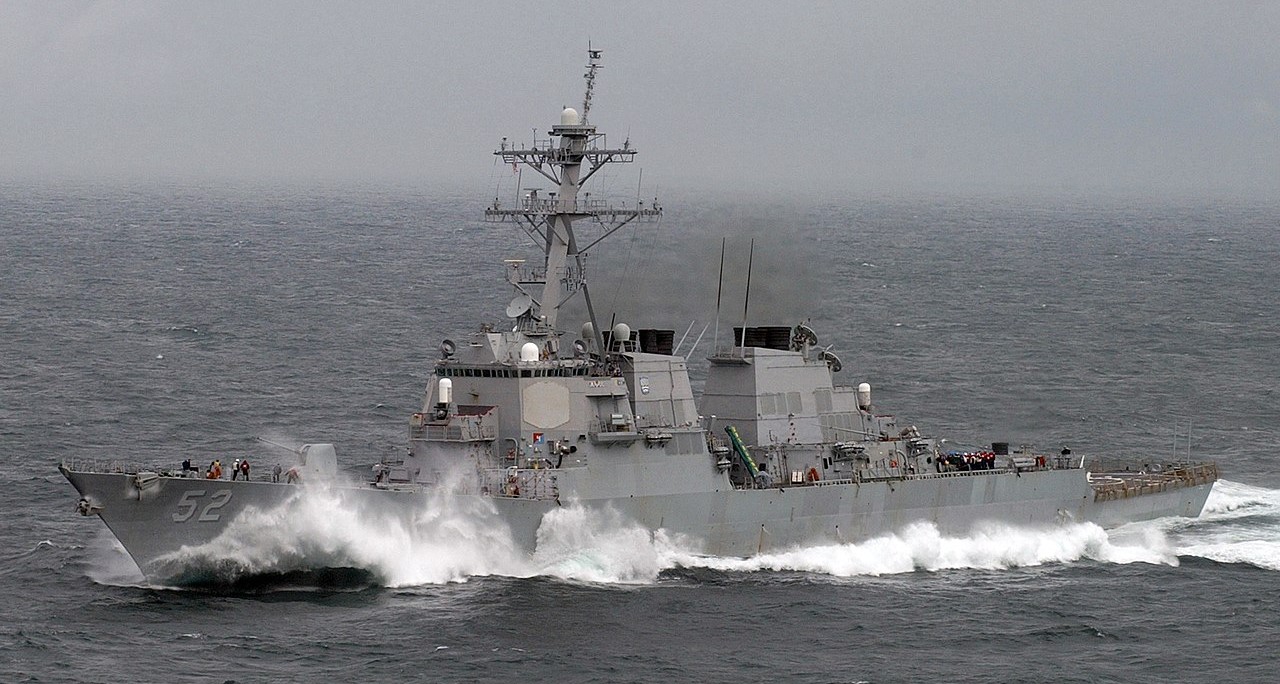
USS Barry (DDG-52) in rough seas
The new design was a major departure from previous US practice in several ways. Previous destroyers had been designed with long, thin hulls for maximum speed in calm water, while the increasing emphasis on the North Sea saw the Burkes get a shorter, wider hull for improved seakeeping. Another major change was a greater emphasis on survivability. All destroyers for the previous two decades had been built essentially assuming that they would be destroyed by any weapon that they couldn't shoot down or decoy. But the new ships had specifications for shock, air blast, electromagnetic pulse and thermal threats, as well as 130 tons of kevlar armor to protect vital spaces. The Burkes also had the first complete CBRN (Chemical, Biological, Radiological, Nuclear) protection system aboard a US warship, which kept the air pressure inside the ship slightly higher than that outside.
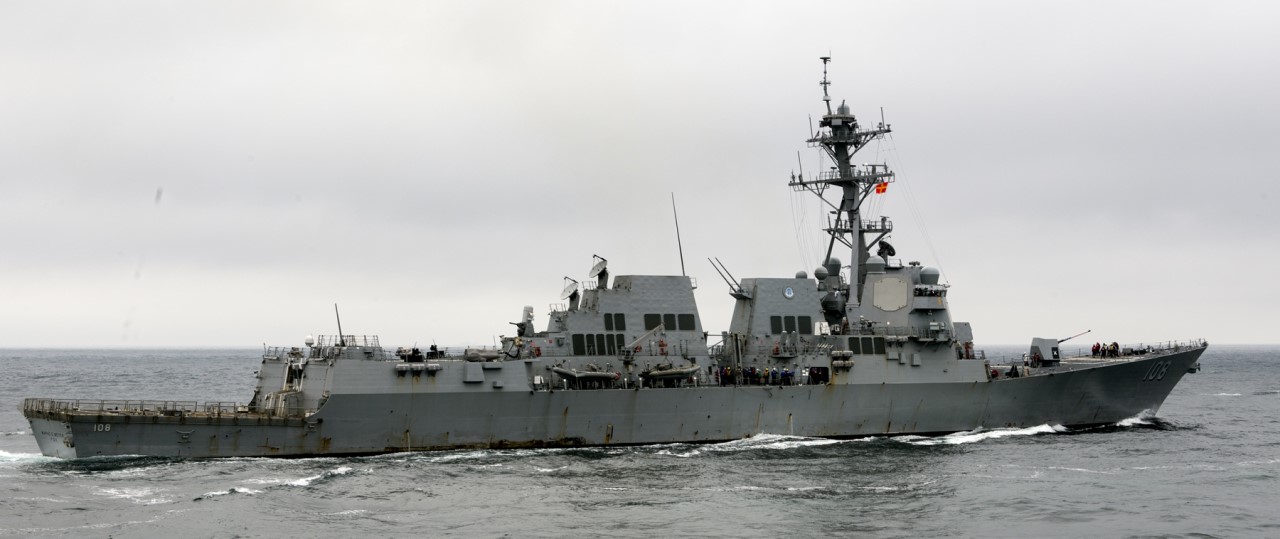
USS Wayne E Meyer (DDG-108)
Another first was an attempt to reduce radar cross section, which should make missile decoys much more effective. This resulted in the abandonment of the distinctive square superstructures of the typical Cold War destroyers in favor of the raked deckhouses that have become ubiquitous over the last two decades. The change also suited another of the designer's goals. Studies had pointed to the importance of presence and appearance in naval power, and the Burkes were deliberately designed to look better than their predecessors. Those earlier classes had mostly had aluminum superstructures, but aluminum tends to soften in intense fires, such as the one aboard the USS Belknap in 1975, and steel was specified for the new destroyers despite the cost in topweight. All of these decisions were made before the Falklands War, which amply confirmed the wisdom of such design choices.
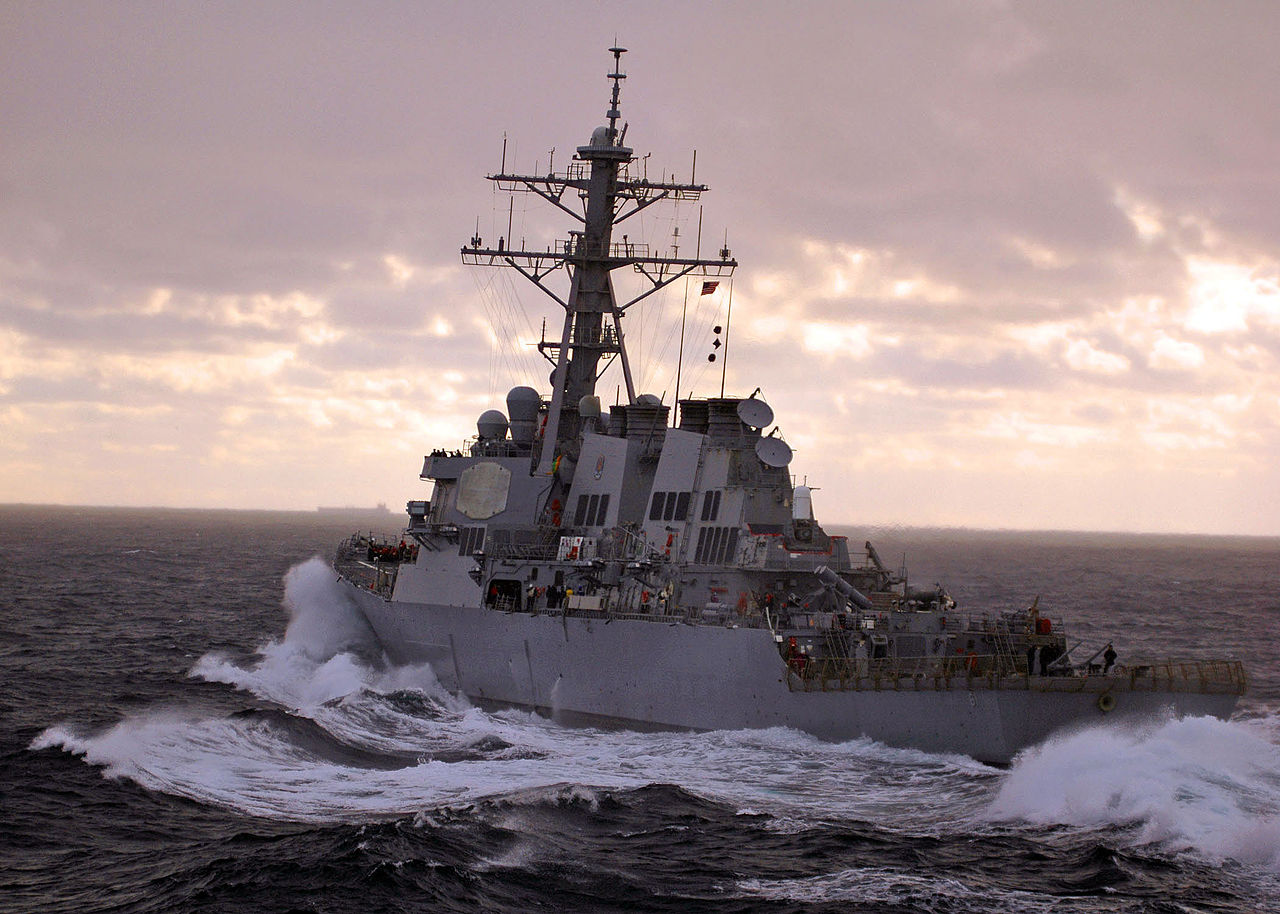
Ramage (DDG-61)
The result of all this was an 8,300 ton vessel, 505' long and with a crew of 303. Besides the VLS, which was split with 29 cells forward and 61 aft, the ship was armed with two quadruple Harpoon launchers, a single 5"/54 gun forward, a pair of Phalanx CIWS forward and aft, and a pair of triple 12.75" torpedo tubes for Mk 46 torpedoes on either side aft.2 A comprehensive electronics fit includes not only the SPY-1/Aegis system, but also surface-search radar, an SQS-53 hull-mounted sonar, a towed-array sonar and an SLQ-32 ESM system, teamed with SRBOC and Nixie decoys.
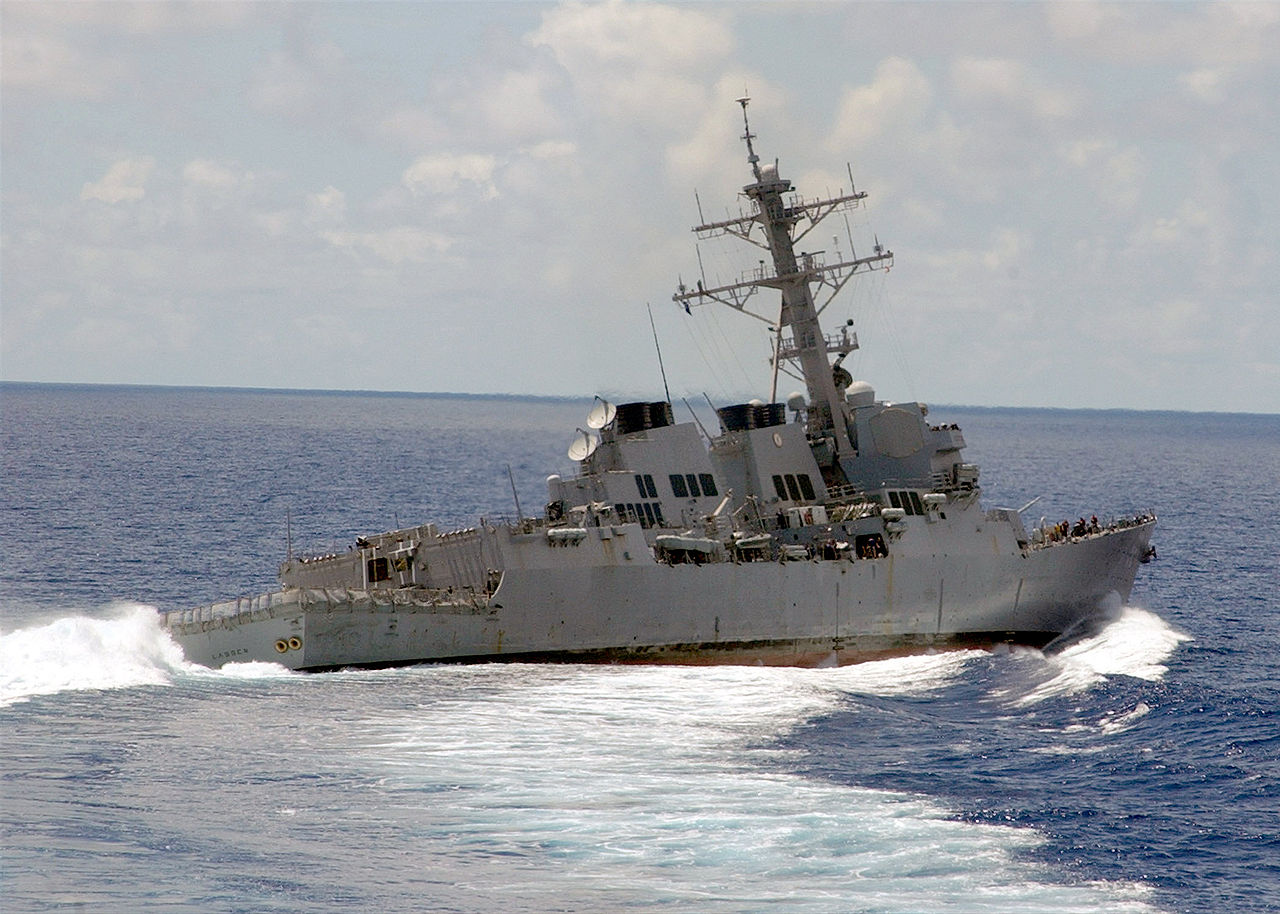
Lassen (DDG-82), an early Flight IIA, showing her hangar doors
But the real strength of the design has been its versatility. From the second ship, USS Barry, onward, they were fitted to refuel and rearm helicopters, a capability Burke herself lacked. Starting with Mahan (DDG-72), the so-called Flight II ships had improved datalinks and a jamming capability added to their SLQ-32. But the real change came seven ships later, with the Flight IIA. A number of design changes reflected the reality that the Cold War was over, and the ships would be serving in a rather different environment than they had been designed for. The biggest change was the addition of a pair of helicopter hangars on either side of the aft VLS for SH-60/MH-60 Seahawk helicopters. In the Persian Gulf, helicopters had proved vital for searching merchant ships, surveillance and as a counter to fast attack craft, all missions that were growing in importance with the retreat of the hot-war threat. Even more important was the fact that the Burkes would make up the bulk of the US surface combatant force going forward, replacing the ships that had been planned to carry helicopters in the early 80s.
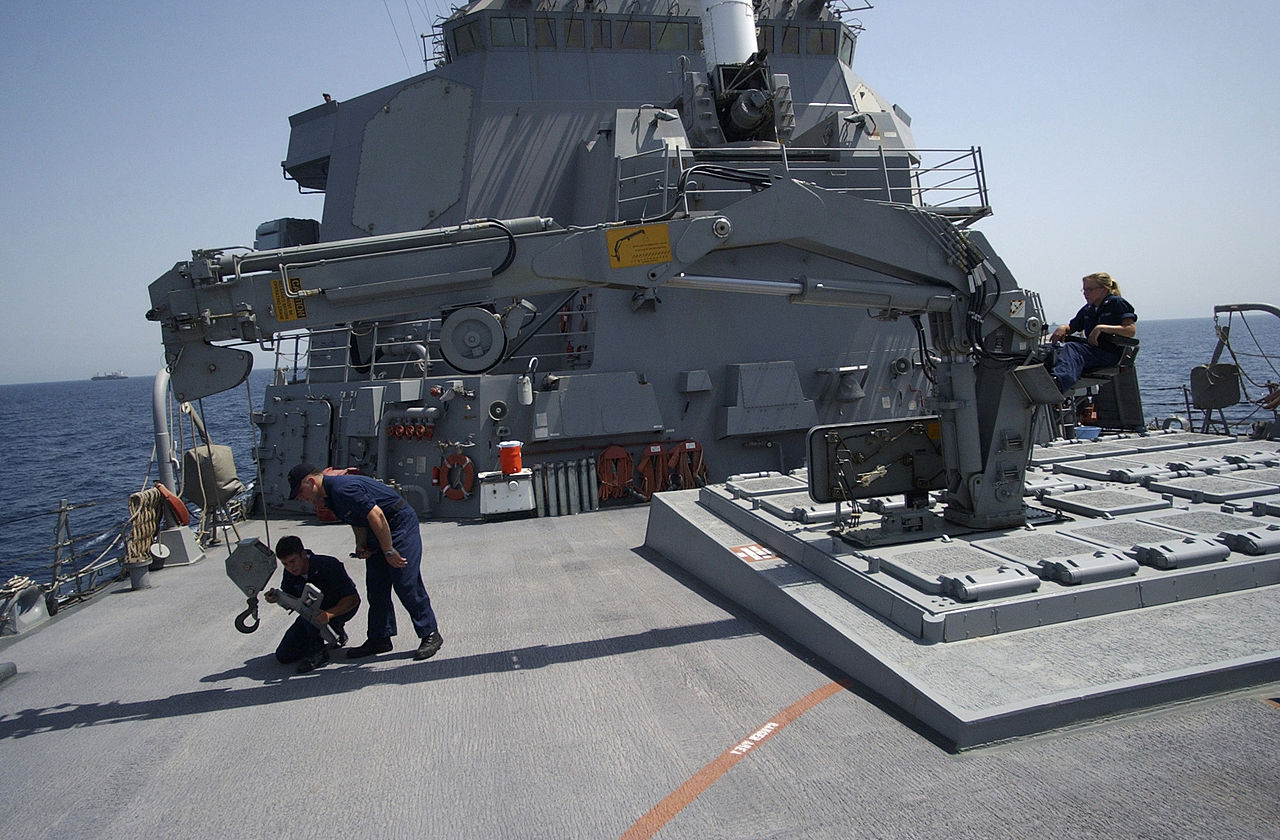
The VLS strikedown crane aboard USS Hopper
Geopolitical changes also drove other alterations to the Flight IIAs. Originally, each VLS had sacrificed three tubes for a crane to allow cells to be reloaded while at sea, with the new missiles transferred from an ammunition ship. When the primary mission was air defense against the Soviet threat, this was a reasonable choice, but with the Burkess now stuffed full of Tomahawks (considerably larger and clumsier than Standards) it made less sense, and the cranes were deleted, giving the new ships 32 cells forward and 64 aft. Another casualty was the Harpoons, landed because of the lack of surface targets and the increasing fear of accidentally hitting a neutral ship. The submarine threat had also diminished, and as a result, the towed array was deleted. CEC was also introduced with Aegis Baseline 6 in the Flight IIAs. The net result was a slightly longer (509') and heavier (9,200 tons) ship.
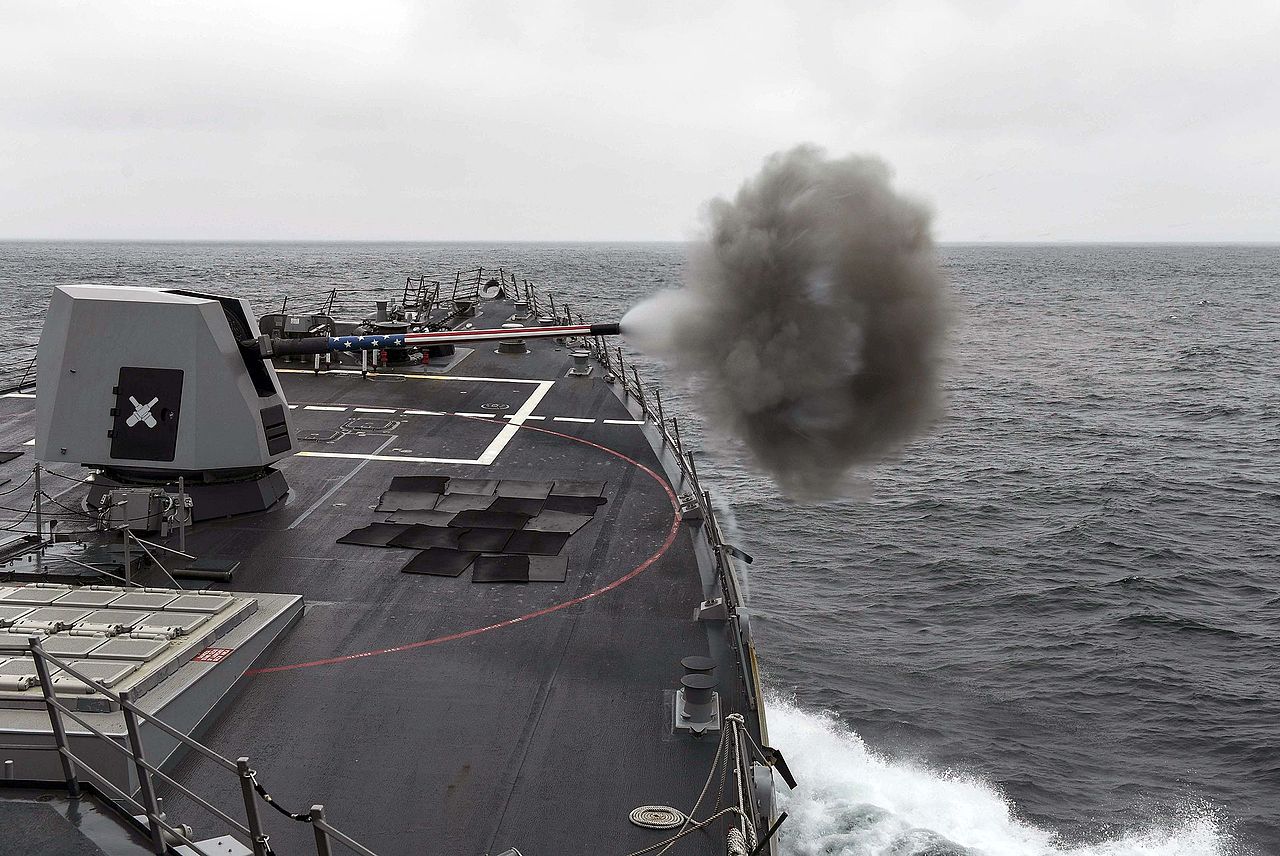
5"/62 gun aboard Wayne E Meyer
Beginning with the third Flight IIA, Winston S Churchill, the gun was replaced with a 5"/62 for improved shore bombardment capability. Some of the Flight IIAs lost one or both of their Phalanx CIWS, as the role was expected to be filled by the RIM-162 Evolved Sea Sparrow Missile (ESSM). This decision was ultimately reversed as the capability of the Phalanx to destroy small boats gained increased importance, with the first six Flight IIAs having both CIWS, and the later ships having one aft. Half a dozen of the early Flight IIAs were fitted to carry the WLD-1 minehunting system, but this was quickly deleted when they realized it didn't fit well with the destroyer mission.
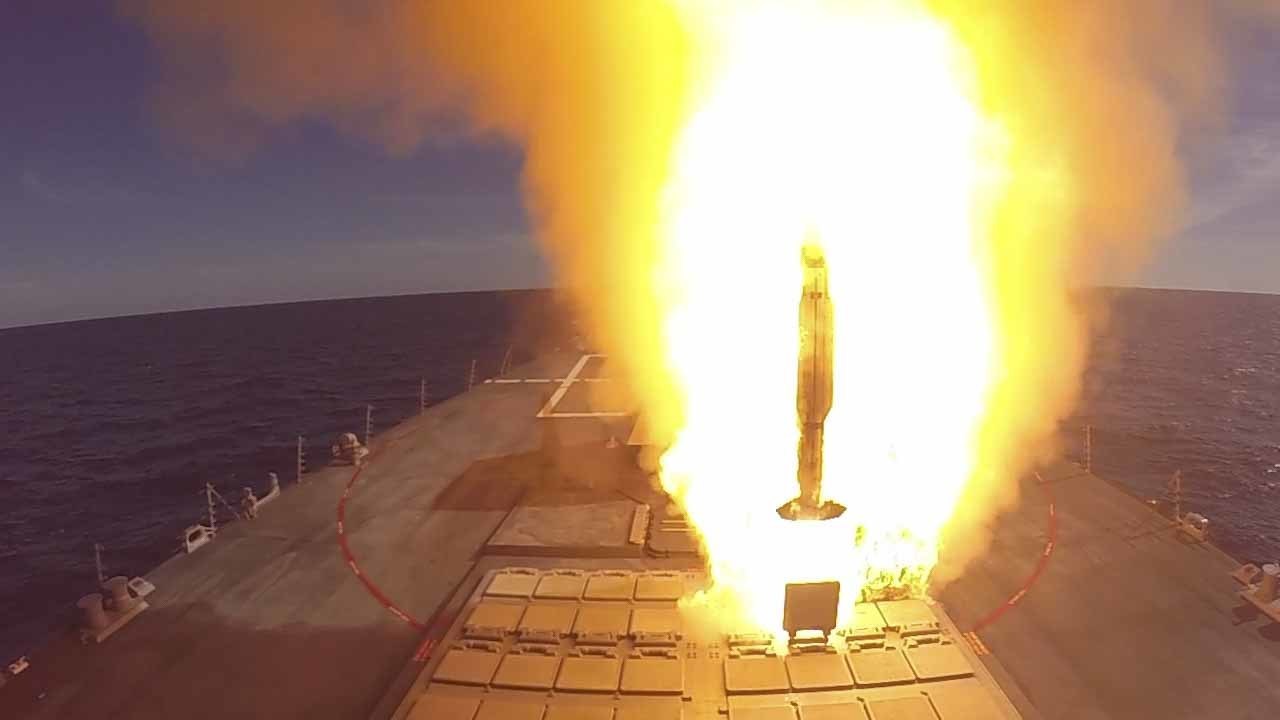
John Finn, the first of the restart ships, fires an SM-2
Procurement of the Burke design was expected to wrap up in FY05, with the last ship (DDG-112) being delivered in 2012 for a total of 28 Flight I/II and 34 Flight IIA ships. They would give way to the Zumwalt class, stealthy and specialized for land-attack missions. However, the Zumwalt program swiftly turned into a complete disaster, and it became clear that they would not be the answer long-term. Instead, it was decided to restart the Burke line, with the first of the new ships being ordered in FY10. The first three were essentially repeats of the Flight IIAs to make sure that the production system was running smoothly, followed by 10 "Technology Insertion" ships that will have upgrades, most notably the replacement of specialized military computers (most dating back to the 80s) with the "Open Architecture Computing Environment" that allows the use of commercial processors. Jack H Lucas (DDG-125) will be the first of the Flight III vessels, which use the new SPY-6 AMDR radar in place of the SPY-1. The AMDR is an active array, giving a major increase in sensitivity and flexibility over the SPY-1. A dozen of these ships are on order, and current projections suggest this number could reach as high as 42.
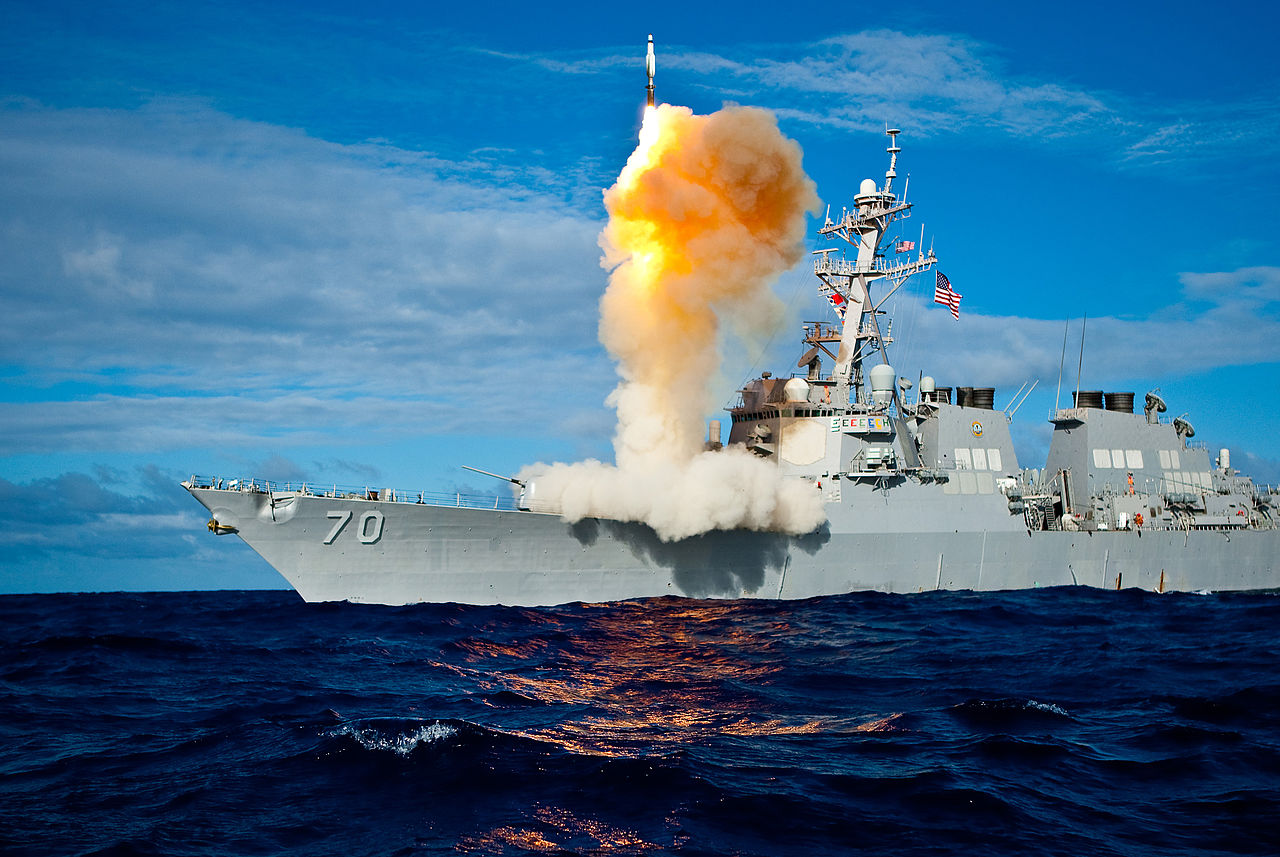
Hopper (DDG-70) fires an SM-3
One of the main reasons that so many of these very capable ships are needed is that technological developments have given the Burkes an important national mission in addition to their normal, naval duties. This mission is ballistic missile defense, thanks to the fact that the Navy's Aegis-based BMD program has proven the most reliable and effective of the nation's various efforts in that sphere. Initially, Aegis-BMD was separate from the main Aegis baseline, and ships fitted with it had their radar transmitter tubes replaced to produce waveforms better suited to ballistic missile defense. This made them more vulnerable to conventional missile attack, and several ships were fitted with SeaRAM to provide self-defense capability while in BMD mode. More recent ships have improved transmitters that can handle both modes at the same time, and when combined with the SM-3 missile, a Burke with the appropriate combat system is a highly-capable missile-defense platform in a world where ballistic missiles are an increasing threat.
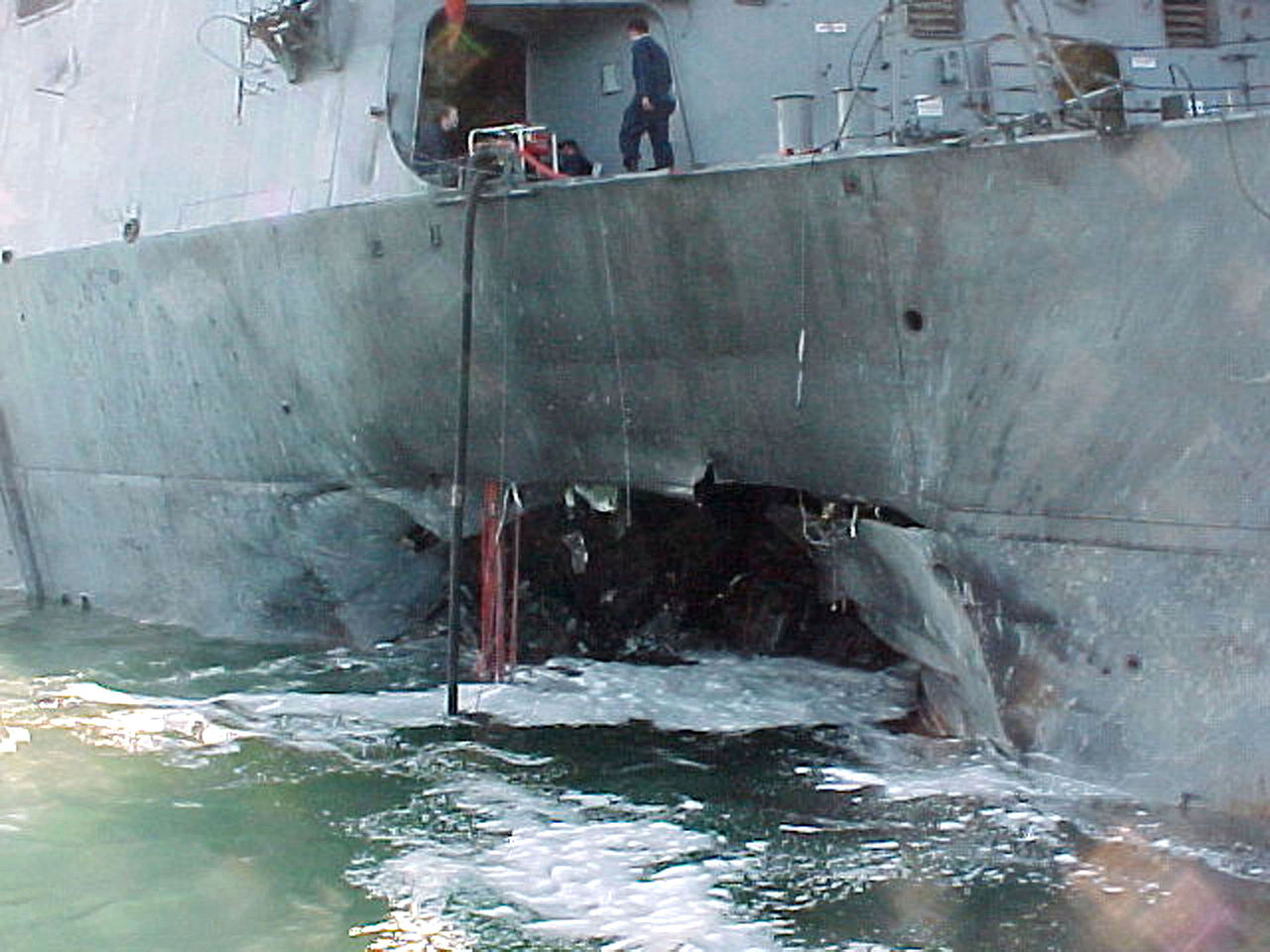
Damage from the bombing of Cole
The Burke class's baptism of fire came in 1996, when Laboon and Russell participated in Tomahawk strikes against Iraq, as they have in every subsequent combat use of the Tomahawk. But the real testament to the design is the survival of the USS Cole after she was attacked while anchored in Aden on October 12th, 2000. A small boat carrying a shaped charge containing several hundred pounds of explosives managed to get right next to the ship before detonating, killing 17 crewmembers and wounding 39 more. Despite extensive damage, the crew successfully fought both fire and flooding, and Cole was eventually returned to service. This incident led to increased concern about the threat of small boats in port, and most ships now have machine guns and even 25mm cannons which are manned while stationary to deal with this threat. Sixteen years later and not very far away, sister ship Mason came under missile attack, and successfully shot down at least one of the incoming ASMs, a first for the USN and proof of the effectiveness of Aegis. Non-combat incidents, in the forms of the collisions suffered by Fitzgerald and John S McCain in the summer of 2017, also testified to the design's ruggedness. More recently, the Burkes have borne the brunt of the campaign against the Houthis in Yemen, shooting down numerous missiles, as well as participating in the defense of Israel against the Iranian ballistic missile attack in April 2024.
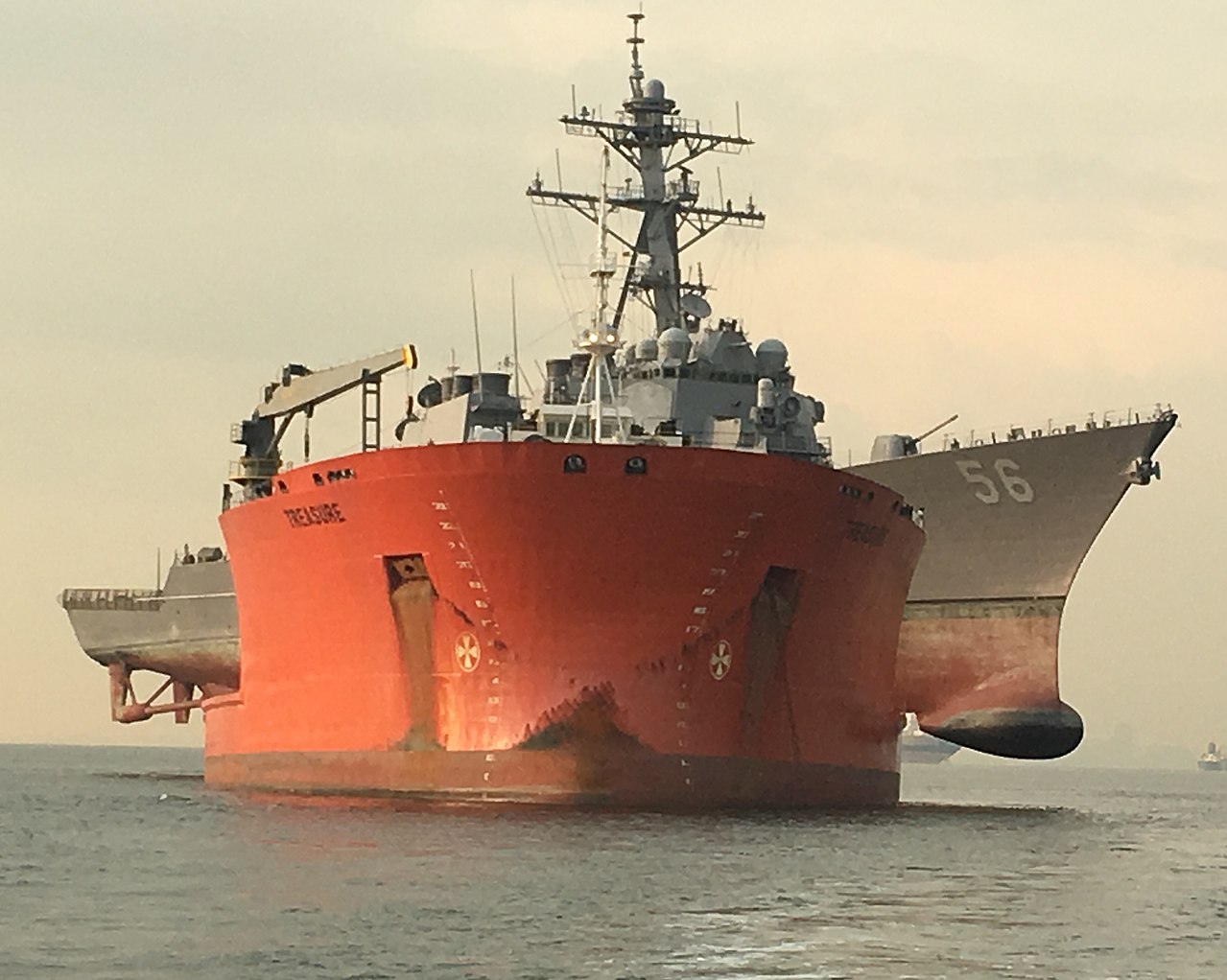
John McCain (DDG-56) aboard heavy-lift ship Treasure
Today, Arleigh Burkes serve around the world, carrying out missions ranging from showing the flag and hunting pirates to protecting carriers from high-end air and submarine threats. Ongoing upgrade programs will keep them relevant, ranging from minor combat system upgrades to a recently-announced plan to fit some ships of the class with a high-energy laser. The class is already the largest American warship program since the end of WWII, and it will give good service for decades to come.
1 FY is Fiscal Year, the schedule the government's budgeting process runs on. Each FY begins on October 1st of the previous calendar year, and decisions about it are usually made during the proceeding calendar year. ⇑
2 The system can also launch Mk 50 and Mk 54 torpedoes, but these are not normally carried. ⇑

Comments
For comparison:
HMS Dreadnought (1905): 18000 tons, 526 feet, 800 crew. HMS Belfast (1936): 11550 tons, 630 feet, 800 crew. HMS Acheron (1931): 1350 tons, 323 feet, 140 crew.
"Two countries separated by a common language" and all that, sure; but nevertheless that there, sir, is no destroyer. That's a light cruiser. And "light" only by comparison to quite late battleships, at that.
@Rolf:
To make the comparisons go even farther: USS Atlanta (CL-51) class: 7400 long tons fully loaded, 541ft length, 52 ft beam (66 ft on a BURKE), 813 crew. That's without going into the ridiculousness of the ZUMWALT class
The modern usage of the type name "destroyer" bears no resemblance to any historical or even Mahanian functional definitions. It's just a word.
Ship classification changes over time, usually moving upward. Yes, by mid-Cold War standards the Burkes are definitely cruisers. Their designation as destroyers is a bit of subterfuge on the part of the USN, who wanted to cast them as cheap ships. There are lots of games played with designations like this. I suspect part of the reason for calling them DDGs instead of CGs was to avoid a push for cheaper destroyers beneath them. Seems to have worked pretty well overall.
But isn't commercial hardware less reliable? On one hand there's EMP, but also they're operating daily in harsher conditions aboard ships than in an office building, or are they?
Then again, light cruisers had to have the endurace to "cruise", ie to perform and/or prevent commerce raiding, right? If I understand correctly, the Burkes are more in the destroyer/capital ship mold, ie focused on a punctual mission, not intended to operate solo long-duration cruises.
Hopefully, soon enough, frigates will be once again the main sub-capital surface combatants, and the whole nomenclature madness that started with "armored frigates" as capital ships and ended with 10.000 ton destroyers will be behind us.
Not necessarily. If you're hardening for EMP, you can stick the chips in a box and make sure that anything going in and out has appropriate protection. As for reliability, it's all silicon, and I don't think there's a huge difference in reliability. Commercial servers are very reliable, too.
As for range, the Burkes do have less than the Ticos (4,400 nm vs 6,000 nm at 20 kts) but that's not the main driver of classification. 4,400 nm is quite a bit, and Burkes do operate independently. (The whole flotilla craft thing went away in the late 40s anyway.)
It's not really madness. The frigate became the cruiser and (indirectly) the battleship. Modern frigates are named after them, but that was just Churchill being Churchill.
Was the decision to only have a landing pad on the Flight I driven by the idea that there would always be a carrier nearby to serve as the hangar for helos? Or another dedicated anti-submarine platform? Or the Ticonderogas?
In practice, though, Arleigh Burke-class destroyers do plenty of "cruising", mainly in the form of port visits to allies that the US wants to reassure and freedom of navigation operations in waters that the US wishes to declare that it has an interest in keeping open.
@redRover
Basically, they did some analysis and said "given the current composition of the fleet, we have plenty of helicopters, and are trying to hold down cost". When the Cold War ended, they realized the Burkes were going to make up more of the fleet as older stuff retired, and gave them hangars.
I'm mildly surprised they had the room to add the hangars, myself. I mean, Bean always says that steel is cheap and air is free, but I was under the impression that on any warship, topside space was limited. Especially with the original designed lack thereof.
Regarding the relative reliability of commercial hardware, there might be some reliability delta given equipment of the same technological vintage, where the commercial version might do less overbuilding or have slightly less robust cooling or similar to save costs. Comparing 2000s commercial computers to 1980s Sperry kit, though, remembering that the "commercial" machines being used here are high-end servers (and likely probably Suns or HP IA-64s at that) rather than cheap Wally World special desktops, nah, they're not really any less reliable.
Software is a different story, but I've seen enough glitchy, klugy weirdness out of MILSPEC bespoke systems that I'm not at all convinced that the software really is any less reliable in the general case.
@Ian
They basically put the hangars on either side of the aft VLS nest and just raised the deck there, so there wasn't really the same topside space constraint you might expect. This is visible if you look at the side of the hull for a Flight I/II (Burke, Barry, Ramage) vs a Flight IIA (Meyer, Lassen). The stuff that was already on deck just got moved up a level, more or less. (I'm sure the details are considerably more complicated.)
Did a bit of looking for pictures of how they did it, and you can see the difference in the height of the aft superstructure between an old one: https://www.navysite.de/dd/Image216.jpg and a new one: https://c8.alamy.com/comp/KGM044/sailors-form-the-number-79-on-the-flight-deck-of-the-arleigh-burke-KGM044.jpg
The two doors on the front edge of the flight deck for the new Burke are helicopter hangars. I can't find a photo at a better angle, but the right-hand ship on https://qph.fs.quoracdn.net/main-qimg-5221b715801e5b0334d408299c5cd3c2 is shown from the appropriate angle.
And yeah, looks like they just jacked up the VLS system by a level. With the split hangar, probably didn't even need to move that many systems around in the process.
In those pictures, why did they paint a volleyball court in front of the gun?
That’s the Vertrep box. If they’re using a helicopter to transfer sling loads of cargo/food/mail between ships, they’ll often drop it on that forward box to keep the flight deck clear. The helicopter never lands, it just puts the sling load on deck and releases it, then flies back to wherever it came from.
Edit: One reason for this might be that it's easier to handle the cargo on the main deck rather than the flight deck. The material handling systems are designed to work with cargo on the main deck, because that's where you get it during Unrep or when pierside, and it might well be easier to just do Vertreps at the same level and not have to worry about getting forklifts onto the flight deck.
@Alsadius
Here’s a good shot of the aft prior to the hangars
from this website that has some other images taken from a book.
Huh. I guess hangars are Mostly Air, so it probably didn't raise their CoG by much, either.
I'm sure they raised it some, but margins for this kind of stuff are built into the design. The Burkes were deliberately built with room to grow, particularly as they have a rather wide hull relative to other warships of the same displacement. (If you see a satellite view of a Burke and a Tico next to each other, the difference is very marked.)
And sometimes "drop" means "literally drop". I have a friend in the Navy, and he's told me that you should not mail anything at all fragile or even slightly breakable (no matter how well it's been packed) to a sailor when they're out at sea. One of the ways mail gets sent to a ship at sea is via VERTREP, and the process is none too gentle on packages.
Dammit Chrome, why must you try and autofill my email in any and every box you find on a form?
@bean
Any chance you could help me remove that?
Fixed.
What I mean is, the word cruiser points to a strategic role, not a ship type. They're supposed to go to an area, sink what they can, avoid getting caught, if possible prevent enemies from doing same.
During the last big naval conflicts, cruisers were relatively large ships with high speed and endurance, well armed (although no battleships) and not very well armored. In the age of sail, it was frigates. AIUI, nowadays, it's fast attack subs.
Ticos weren't designed to cruise. If I understand correctly, neither were Burkes. They just got named "destroyer" because it sounded cheap, and "cruiser" because that's what the Soviets called theirs and it sounds awesome. But the name doesn't match the meaning, and the result is confusion, not of the enemy, but of the actual public that has to support and ultimately pay for these ships.
That's not their wartime role, and in that context cruising doesn't mean courtesy visits.
On one hand, yes, the current cruisers aren't likely to cruise. In fairness, that hasn't really been a thing since WWII at the latest, and that role is filled by submarines these days. But the names stopped having a close relationship with ship types a long time ago. The US cruisers in WWII never did much cruising either. It's been decades since a destroyer destroyed a torpedo boat, and that's definitely not their primary role anymore.
If ship type names are fairly arbitrary, then there is nothing stopping a new "battleship" class from being devised.
Any suggestions?
@Doctorpat: see here.